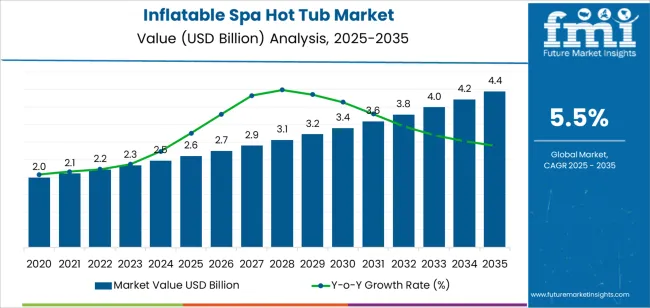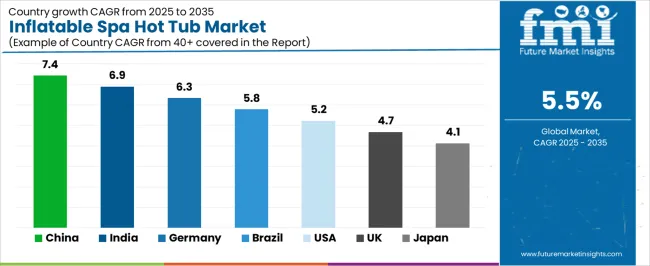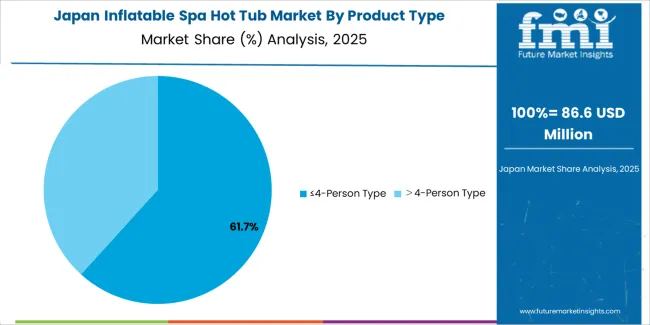The inflatable spa hot tub market is expected to expand from USD 2.6 billion in 2025 to USD 4.4 billion by 2035, at a CAGR of 5.5%, with product and application segments shaping overall growth momentum. The ≤4-person segment leads with a 62% share, supported by its compact size, lower heating load, and compatibility with balconies, patios, and small residential outdoor spaces. These models appeal to first-time wellness buyers who prioritise portability, quick installation, and energy-efficient hydrotherapy, without requiring structural reinforcement. Reinforced PVC shells, multi-layer insulation, and upgraded pump-heater combinations improve temperature retention and jet performance, making ≤4-person units the largest contributor to incremental volume through 2035. The >4-person segment at 38% serves larger households and rental properties that require expanded seating, stronger jet systems, and reinforced wall rigidity for extended seasonal use.
The household segment dominates with a 71% share, driven by rising interest in home-based leisure, stress-relief routines, and backyard living improvements. Portable hot tubs provide a lower-commitment alternative to fixed spas, encouraging adoption among renters, frequent movers, and space-limited urban users. The commercial segment, at 29%, is gaining traction in vacation rentals, boutique stays, small spas, and resort properties, integrating inflatable models as flexible, seasonal amenities that require minimal installation effort.

Asia Pacific leads market growth, supported by expanding urban homeownership and rising interest in home leisure products in China, Japan, and Australia. Europe and North America maintain strong demand through established outdoor recreation markets and increased consumer spending on home-based wellness. Key companies include Intex Recreation Corp., SereneLife, Coleman, Lay-Z-Spa, Bestway, MSpa, and ROTOSPA, focusing on product durability, user-friendly setup, and enhanced hydrotherapy features.
Saturation point analysis shows a gradual movement from early expansion toward moderated, maturity-stage demand. Between 2025 and 2029, the market will remain well below saturation, supported by rising household adoption, increased interest in at-home leisure products, and broader availability through online retail channels. Product improvements in durability, pump efficiency, and temperature control will reinforce early growth across North America, Europe, and Asia Pacific.
Between 2030 and 2035, the market will begin approaching its initial saturation point as penetration rises in key consumer segments and discretionary spending stabilizes. Growth will slow modestly as replacement purchases and model upgrades become the primary drivers in mature regions. Continued demand will come from technology refinements, including improved insulation materials and energy-efficient heating systems, which encourage periodic product renewal. The saturation pattern reflects a consumer-goods market evolving from rapid lifestyle-driven expansion to a stable, replacement-oriented phase shaped by product lifecycle dynamics, incremental innovation, and steady engagement in the home-wellness category.
| Metric | Value |
|---|---|
| Market Value (2025) | USD 2.6 billion |
| Market Forecast Value (2035) | USD 4.4 billion |
| Forecast CAGR (2025-2035) | 5.5% |
The inflatable spa hot tub market is growing as households look for affordable and portable wellness products that provide relaxation without the cost and installation requirements of permanent spas. Rising interest in home leisure, combined with higher disposable income in many regions, encourages consumers to adopt compact spas that can be installed quickly in small indoor or outdoor spaces. Improvements in materials, heater units, air-jet systems and control panels enhance durability and user convenience, which increases consumer confidence. The expansion of online retail platforms also broadens product availability and supports strong demand from renters, frequent movers and short-term accommodation owners who prefer non-permanent installations.
Growth is reinforced by the popularity of at-home recreation during seasonal peaks and by the trend toward modest self-care routines. Challenges include limited lifespan compared with fixed hot tubs, seasonal fluctuations in demand and concerns about energy use or water maintenance among new users. Competition from permanent spas and lower cost inflatable pools also influences buying decisions in some markets.
The inflatable spa hot tub market is segmented by product type and application. By product type, the market includes ≤4-person type and >4-person type models. Based on application, it is categorized into household and commercial use. Regionally, the market is divided into Asia Pacific, Europe, North America, and other key regions.

The ≤4-person type segment holds the leading position in the inflatable spa hot tub market, representing an estimated 62.0% of total market share in 2025. These compact models are widely adopted in residential environments due to their lower space requirements, ease of installation, and affordable pricing relative to larger units. They are suitable for balconies, patios, small yards, and indoor recreational areas.
The segment’s dominance is supported by growing consumer demand for personal relaxation equipment and rising preference for portable wellness products in urban households. The >4-person type segment, estimated at 38.0%, is used in spacious residential settings, rental properties, and small commercial establishments requiring higher occupancy and enhanced seating layouts.
Key factors supporting the ≤4-person type segment include:

The household segment accounts for approximately 71.0% of the inflatable spa hot tub market in 2025. Residential users adopt inflatable hot tubs for leisure, stress relief, and home-based wellness routines. Their portable design, combined with lower cost compared to fixed-installed spas, supports high demand among families and individuals seeking accessible hydrotherapy options.
The commercial segment, representing about 29.0%, includes hotels, vacation rentals, spas, and recreational facilities using inflatable hot tubs as temporary or seasonal amenities. Commercial adoption is influenced by the need for flexible installation, mobility, and cost-efficient guest amenities.
Primary dynamics driving demand from the household segment include:
The Inflatable Spa Hot Tub Market is expanding as consumers seek accessible ways to experience hydrotherapy and relaxation at home. Rising interest in wellness, stress reduction, and outdoor leisure encourages households to adopt portable spas that require minimal installation and can fit in smaller outdoor spaces. Growth in residential renovation and backyard improvement projects also supports demand for inflatable hot tubs as an alternative to fixed spas. Manufacturers are improving product durability, pump efficiency, and temperature stability, which increases user confidence and long-term usability. Broader retail availability across online platforms makes it easier for buyers to compare models, leading to steady adoption across varied income groups and housing types.
Inflatable hot tubs generally have shorter lifespans than hard-shell units due to material wear, puncture risk, and exposure to varying weather conditions. Users in cold or extremely fluctuating climates may face performance limitations because heating efficiency decreases and structural materials become more vulnerable in low temperatures. Regular water treatment, filter changes, and cleaning are essential for safe operation, which increases the maintenance burden for first-time spa owners. Electricity use during prolonged heating cycles may also raise operational costs for some consumers, limiting adoption in energy-sensitive regions.
Manufacturers are introducing energy-efficient pump and heater combinations that lower running costs and improve year-round usability. Multi-person inflatable tubs with reinforced walls, improved insulation, and adjustable jet systems are gaining popularity among families and shared households. Urban buyers with limited space are adopting compact models that can be stored easily during off-season months. Integration of digital control panels, app-based temperature settings, and upgraded filtration technology is improving user convenience and enhancing product appeal across residential markets.
The global inflatable spa hot tub market is expanding through 2035, supported by rising interest in at-home wellness products, growth in online retail channels, and increased consumer preference for portable relaxation equipment. China leads with a 7.4% CAGR, followed by India at 6.9%, reflecting strong household adoption and growing participation in the home-leisure segment. Germany grows at 6.3%, driven by regulated quality standards and steady use in residential wellness setups. Brazil records 5.8%, supported by expanding urban housing and digital retail penetration. The United States grows at 5.2%, while the United Kingdom (4.7%) and Japan (4.1%) maintain stable demand through compact-home wellness solutions and consistent replacement purchases.

| Country | CAGR (%) |
|---|---|
| China | 7.4 |
| India | 6.9 |
| Germany | 6.3 |
| Brazil | 5.8 |
| USA | 5.2 |
| UK | 4.7 |
| Japan | 4.1 |
China’s market grows at 7.4% CAGR, supported by increasing consumer interest in home-leisure products, rising disposable income, and broader adoption of inflatable spa systems across urban households. Domestic manufacturers supply PVC-reinforced and fiber-mesh designs suited for varied climatic conditions, integrating features such as adjustable jets, multi-stage filtration, and energy-efficient heating. E-commerce platforms expand access to mid-range and premium inflatable units, enabling wider distribution across cities and suburban regions. Growth in residential-wellness consumption and backyard leisure activities strengthens ongoing adoption.
Key Market Factors:
India’s market grows at 6.9% CAGR, driven by expanding urban housing, rising interest in compact home-wellness equipment, and broader adoption among upper-income households. Inflatable spa hot tubs are used in residential balconies, terraces, and villa settings where portable products offer flexibility without structural installation. Domestic distributors supply reinforced PVC and multi-layer insulated designs suited for varied seasonal use. Growth in online retail and lifestyle-product consumption increases accessibility across metro and Tier-2 markets. Rising hospitality and homestay activity also strengthens procurement of portable spa systems.
Market Development Factors:

Germany’s market grows at 6.3% CAGR, supported by strong consumer preference for regulated, durable, and energy-efficient wellness products. Inflatable spa hot tubs are incorporated into home-relaxation setups, garden areas, and seasonal leisure spaces. Manufacturers supply thermally insulated, puncture-resistant designs meeting European safety and material-quality guidelines. Growth in outdoor lifestyle products and structured home-wellness routines increases adoption among homeowners. Retail distributors expand offerings with energy-efficient heating units and user-friendly control interfaces aligned with local efficiency expectations.
Key Market Characteristics:
Brazil’s market grows at 5.8% CAGR, driven by rising urban apartment living, increased interest in compact leisure equipment, and broader participation in digital retail channels. Households adopt inflatable spa tubs for balconies, patios, and small outdoor spaces where permanent installations are less feasible. Retailers offer models designed for warm-climate operation with reinforced PVC and simplified filtration systems. Growth in middle-income leisure spending supports broader adoption. Seasonal demand increases during holiday and vacation periods, strengthening sales across major metropolitan regions.
Market Development Factors:

The United States grows at 5.2% CAGR, supported by widespread interest in home-wellness products, strong backyard-recreation trends, and broad availability of energy-efficient inflatable spa systems. Consumers adopt portable hot tubs for patios, decks, and residential recreation spaces, benefiting from plug-and-play installation and adjustable hydro-therapy features. Manufacturers supply insulated walls, digital control panels, and multi-stage filtration adapted for varying climates. Retailers and online platforms expand offerings across all price categories, supporting consistent household adoption.
Key Market Factors:
The United Kingdom’s market grows at 4.7% CAGR, supported by increasing adoption of seasonal outdoor leisure products and rising interest in compact home-wellness systems. Households use inflatable spa tubs in gardens and patios where portable models suit space-limited housing. Domestic and European suppliers offer insulated, energy-efficient designs suited for cooler climates. Retailers expand product ranges across spring and summer periods, with consistent digital-channel sales. Broader interest in affordable outdoor relaxation strengthens long-term market stability.
Market Development Factors:

Japan’s market grows at 4.1% CAGR, supported by compact residential layouts, established home-wellness habits, and demand for portable relaxation products. Inflatable spa hot tubs are used in balconies, small patios, and indoor wellness spaces where permanent installations are impractical. Domestic suppliers focus on compact, lightweight, and thermally efficient models designed for limited space. Growth in home-relaxation culture, digital shopping channels, and lifestyle-product adoption supports stable procurement across major urban regions.
Key Market Characteristics:

The inflatable spa hot tub market is moderately fragmented, with about ten manufacturers supplying portable hydrotherapy products for residential and leisure use. Intex Recreation Corp. leads the market with an estimated 20.0% global share, supported by its wide product portfolio, consistent build quality, and strong retail presence across North America and Europe. Its leadership is reinforced by durable PVC construction, stable pump systems, and reliable aftersales support.
Bestway, Lay-Z-Spa, and Coleman follow as major competitors, offering affordable models with integrated heating and bubble-massage systems. Their competitive strengths include broad distribution channels, seasonal product availability, and designs suited to general household use. MSpa and SereneLife maintain mid-tier positions through compact, energy-efficient units emphasizing ease of installation and lightweight portability.
Manufacturers such as ROTOSPA, CAMBS HOT TUBS LTD, and Arctic Spas contribute niche offerings, focusing on enhanced insulation and rugged construction for colder climates. GYMAX and ALEKO expand regional supply through cost-effective models sold via online marketplaces.
Competition in this market centers on material durability, heater efficiency, pump reliability, user convenience, and safety compliance. Market growth is supported by increased demand for home-based leisure equipment, wider acceptance of portable spa systems, and continued improvement in energy-efficient heating and reinforced inflatable wall structures that extend product lifespan in household environments.
| Items | Values |
|---|---|
| Quantitative Units | USD billion |
| Product Type | ≤4-Person Type, >4-Person Type |
| Application | Household, Commercial |
| Regions Covered | Asia Pacific, Europe, North America, Latin America, Middle East & Africa |
| Countries Covered | India, China, USA, Germany, South Korea, Japan, Italy, and 40+ countries |
| Key Companies Profiled | Intex Recreation Corp., SereneLife, Coleman, Lay-Z-Spa, Bestway, MSpa, ROTOSPA, CAMBS HOT TUBS LTD, Arctic Spas, GYMAX, ALEKO |
| Additional Attributes | Dollar sales by product type and application categories; regional adoption trends across Asia Pacific, Europe, and North America; competitive landscape of inflatable spa and portable hot tub manufacturers; advancements in durable PVC construction, water heating efficiency, and rapid-inflation systems; integration with household leisure, hospitality, and commercial wellness facilities. |
The global inflatable spa hot tub market is estimated to be valued at USD 2.6 billion in 2025.
The market size for the inflatable spa hot tub market is projected to reach USD 4.4 billion by 2035.
The inflatable spa hot tub market is expected to grow at a 5.5% CAGR between 2025 and 2035.
The key product types in inflatable spa hot tub market are ≤4-person type and >4-person type.
In terms of application, household segment to command 71.0% share in the inflatable spa hot tub market in 2025.






Our Research Products

The "Full Research Suite" delivers actionable market intel, deep dives on markets or technologies, so clients act faster, cut risk, and unlock growth.

The Leaderboard benchmarks and ranks top vendors, classifying them as Established Leaders, Leading Challengers, or Disruptors & Challengers.

Locates where complements amplify value and substitutes erode it, forecasting net impact by horizon

We deliver granular, decision-grade intel: market sizing, 5-year forecasts, pricing, adoption, usage, revenue, and operational KPIs—plus competitor tracking, regulation, and value chains—across 60 countries broadly.

Spot the shifts before they hit your P&L. We track inflection points, adoption curves, pricing moves, and ecosystem plays to show where demand is heading, why it is changing, and what to do next across high-growth markets and disruptive tech

Real-time reads of user behavior. We track shifting priorities, perceptions of today’s and next-gen services, and provider experience, then pace how fast tech moves from trial to adoption, blending buyer, consumer, and channel inputs with social signals (#WhySwitch, #UX).

Partner with our analyst team to build a custom report designed around your business priorities. From analysing market trends to assessing competitors or crafting bespoke datasets, we tailor insights to your needs.
Supplier Intelligence
Discovery & Profiling
Capacity & Footprint
Performance & Risk
Compliance & Governance
Commercial Readiness
Who Supplies Whom
Scorecards & Shortlists
Playbooks & Docs
Category Intelligence
Definition & Scope
Demand & Use Cases
Cost Drivers
Market Structure
Supply Chain Map
Trade & Policy
Operating Norms
Deliverables
Buyer Intelligence
Account Basics
Spend & Scope
Procurement Model
Vendor Requirements
Terms & Policies
Entry Strategy
Pain Points & Triggers
Outputs
Pricing Analysis
Benchmarks
Trends
Should-Cost
Indexation
Landed Cost
Commercial Terms
Deliverables
Brand Analysis
Positioning & Value Prop
Share & Presence
Customer Evidence
Go-to-Market
Digital & Reputation
Compliance & Trust
KPIs & Gaps
Outputs
Full Research Suite comprises of:
Market outlook & trends analysis
Interviews & case studies
Strategic recommendations
Vendor profiles & capabilities analysis
5-year forecasts
8 regions and 60+ country-level data splits
Market segment data splits
12 months of continuous data updates
DELIVERED AS:
PDF EXCEL ONLINE
Inflatable U Shaped Travel Pillow Market Size and Share Forecast Outlook 2025 to 2035
Inflatable Tent Market Size and Share Forecast Outlook 2025 to 2035
Inflatable Packaging Market Forecast and Outlook 2025 to 2035
Inflatable Bags Packaging Market Size, Share & Forecast 2025 to 2035
Inflatable Pouches Market
Inflatable Pet Collars Market
Inflatable Void Fill System Market
Foldable Inflatable Boats Market Size and Share Forecast Outlook 2025 to 2035
Portable & Inflatable Swimming Pool Market Trends - Growth & Demand to 2025 to 2035
Automotive Inflatable Seat Belt Market
Fully Sealed Fully Insulated Inflatable Cabinet Market Size and Share Forecast Outlook 2025 to 2035
Spain Sports Tourism Market Size and Share Forecast Outlook 2025 to 2035
Spark Detection System Market Forecast and Outlook 2025 to 2035
Space-based C4ISR Market Size and Share Forecast Outlook 2025 to 2035
Spasticity Treatment Market Size and Share Forecast Outlook 2025 to 2035
Space Lander and Rover Market Size and Share Forecast Outlook 2025 to 2035
Space-Based Solar Power Market Size and Share Forecast Outlook 2025 to 2035
Space Frame Market Size and Share Forecast Outlook 2025 to 2035
Spatial Computing Market Size and Share Forecast Outlook 2025 to 2035
Space Situational Awareness Market Size and Share Forecast Outlook 2025 to 2035

Thank you!
You will receive an email from our Business Development Manager. Please be sure to check your SPAM/JUNK folder too.
Chat With
MaRIA